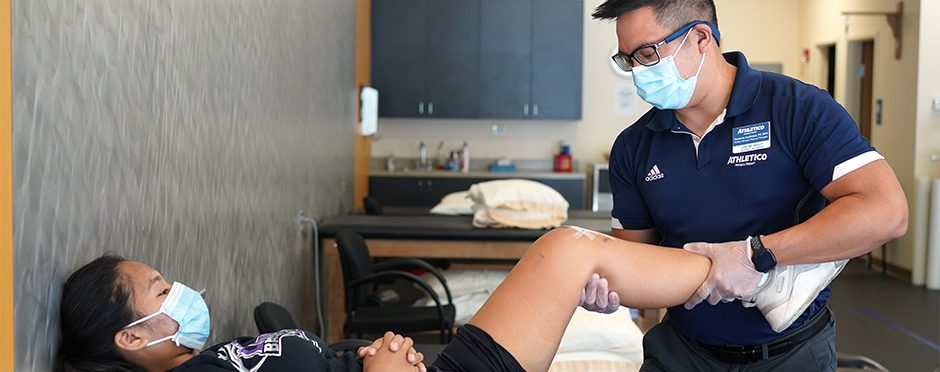
How to Succeed in PT following ACL Reconstruction Surgery
Leave a Comment“I don’t really have the words right now, definitely not the right ones at least,” this was the quote from Odell Beckham Jr. following his 2nd ACL tear during Superbowl LVI. Most people know that an ACL tear is a common knee injury that requires a long, tenacious recovery. Once an ACL is torn, the risk of re-tear or tearing the opposite side is 20-35% more likely4. The above statistic may be alarming and is why ACL reconstruction rehabilitation needs to be taken very seriously.
How Do ACL Tears Happen?
An ACL tear can occur in contact or non-contact incidents. A non-contact ACL injury typically occurs when the knee collapses and rotates inward in the same motion. An ACL tear from contact typically occurs with a blow to the knee from the side.
Expectations Following an ACL Injury
- Physical therapy prior to surgery to normalize range of motion and walking mechanics, as well as reduce swelling
- Physical therapy will start following surgery, usually within 2-7 days
- Weight-bearing status and use of crutches are dependent on the physician’s protocol, but typically the patient can weight bear as tolerated with crutches
- By six weeks post-op, the goal is to have close to a normal range of motion and walking mechanics again
- Jogging can begin around the three-month mark but should not be performed until there is adequate single leg knee and hip strength
- Return to sport SHOULD NOT occur before nine months; the research has proven it takes 9-12 months to fully recover and allow for adequate healing of the ACL before returning to high-level activities
Keys/Milestones in Post-Surgical ACL Rehabilitation
- Normalize the range of motion of the surgical knee – regaining your normal range of motion is the first key step to achieve following surgery.
- Achieve good quadriceps activation and strength –visibly seeing your quad muscle activate and perform a straight leg raise with NO knee bend is critical.
- Normalize your walking mechanics – assuring you can walk without a limp will help improve your outcomes. The sooner you normalize this the better off you will be.
- Perform bilateral leg strengthening – focusing on quadriceps, hamstring, gluts, and soleus strengthening to help to stabilize the knee and protect the newly reconstructed ACL.
- Making sure to work on your muscular strength, hypertrophy, and endurance is critical – reach out to an ACL specialized physical therapist for more information on strength training programming.
- Implement reactive, reflexive, neuromuscular, and cognitive training towards the end of physical therapy – this will help with improving how you move, decision making, and leg spatial awareness to reduce the risk of re-tear.
- This will include learning where your leg is in space, how to land on your leg, and improving balance on both of your legs. Training the non-surgical leg is just as important as training the surgical leg.
- Pass return to sport testing prior to returning to sport – this will include strength testing, hop testing, quality of movement testing, and a psychological assessment after at least nine months to safely return.
ACL Tear Prevention
To help with ACL tear prevention and to improve outcomes for functional outcomes following an ACL tear and surgery, Athletico Physical Therapy offers the ACL 3P Program. ACL tears maybe prevented with the right strengthening exercise and movement analysis. Proper risk assessment and return to sport testing can reduce re-injury rates by 84%.
Are you at risk for an ACL tear? Contact Athletico for a free assessment. The Athletico team will look at biomechanics and movement patterns to determine the best course of action for you to prevent ACL tears or injury.
If you are interested in learning more about Athletico’s ACL 3P Program, including ACL risk assessment, please email acl@athletico.com.
*Per federal guidelines, beneficiaries of plans such as Medicare, Medicaid, Tricare, VHA and other federally funded plans are not eligible for free assessments.
The Athletico blog is an educational resource written by Athletico employees. Athletico bloggers are licensed professionals who abide by the code of ethics outlined by their respective professional associations. The content published in this blog is for informational purposes only, does not constitute medical advice and should not be relied on for making personal health decisions.
References:
1. Anterior cruciate ligament (ACL) injury. Physiopedia. (n.d.). Retrieved May 6, 2022, from https://www.physio-pedia.com/Anterior_Cruciate_Ligament_(ACL)_Injury
2. Paterno, M. V., Rauh, M. J., Schmitt, L. C., Ford, K. R., & Hewett, T. E. (2012, March). Incidence of contralateral and ipsilateral anterior cruciate ligament (ACL) injury after primary ACL reconstruction and return to sport. Clinical journal of sport medicine: official journal of the Canadian Academy of Sport Medicine. Retrieved May 6, 2022, from https://www.ncbi.nlm.nih.gov/pmc/articles/PMC4168893/
3. Trotter, J. (2020, October 30). Cleveland browns’ odell beckham jr. says ACL tear ‘really tough,’ promises to be back soon. ESPN. Retrieved May 6, 2022, from https://www.espn.com/nfl/story/_/id/30224563/cleveland-browns-odell-beckham-jr-says-acl-tear-really-tough-promises-back-soon
4. Wang , W. (n.d.). Get your athletes back in the game after ACL surgery.
